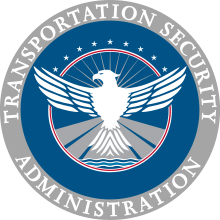
Back إدارة أمن النقل Arabic Transportation Security Administration Czech Transportation Security Administration German Administración de Seguridad en el Transporte Spanish اداره امنیت حمل و نقل Persian Transportation Security Administration French רשות אבטחת התעבורה של ארצות הברית HE Transportation Security Administration Croatian Administrasi Keamanan Transportasi ID Transportation Security Administration Italian
 TSA seal | |
 TSA wordmark | |
 TSA flag | |
| Agency overview | |
|---|---|
| Formed | November 19, 2001 |
| Preceding agency |
|
| Jurisdiction | Transportation systems inside, and connecting to, the United States of America |
| Headquarters | Springfield, Fairfax County, Virginia U.S. |
| Employees | 54,200+ (FY 2020) |
| Annual budget | $9.70 billion (FY 2023) |
| Agency executives |
|
| Parent department | Department of Homeland Security |
| Website | TSA.gov |
The Transportation Security Administration (TSA) is an agency of the United States Department of Homeland Security (DHS) that has authority over the security of transportation systems within and connecting to the United States. It was created as a response to the September 11 attacks to improve airport security procedures and consolidate air travel security under a combined federal law enforcement and regulatory agency.[1]
The TSA develops key policies to protect the U.S. transportation system, including highways, railroads, bus networks, mass transit systems, ports, pipelines, and intermodal freight facilities. It fulfills this mission in conjunction with other federal, state, local and foreign government partners. However, the TSA's primary mission is airport security and the prevention of aircraft hijacking. It is responsible for screening passengers and baggage at more than 450 U.S. airports, employing screening officers, explosives detection dog handlers, and bomb technicians in airports, and armed Federal Air Marshals and Federal Flight Deck Officers on aircraft.[2]
At first a part of the Department of Transportation, the TSA became part of DHS in March 2003. It is currently led by Administrator David Pekoske and is headquartered in Springfield, Virginia. As of the fiscal year 2023, the TSA operated on a budget of approximately $9.70 billion and employed over 47,000 Transportation Security Officers, Transportation Security Specialists, Federal Air Marshals, and other security personnel.
The TSA has screening processes and regulations related to passengers and checked and carry-on luggage, including identification verification, pat-downs, full-body scanners, and explosives screening. Since its inception, the agency has been subject to criticism and controversy regarding the effectiveness of various procedures, as well as incidents of baggage theft, data security, and allegations of prejudicial treatment towards certain ethnic groups.[3] Undercover tests conducted by the Department of Homeland Security have shown that the TSA's failure rate frequently ranges between 80% and 95%.[4][5]
- ^ "MINETA OUTLINES MISSION FOR TSA, SECURITY DIRECTORS". FreightWaves. January 16, 2002. Retrieved April 11, 2021.
- ^ "TSAJobs Home". hraccess.tsa.dhs.gov. Archived from the original on August 7, 2015.
- ^ "TSA screening program risks racial profiling amid shaky science – study". the Guardian. February 8, 2017. Retrieved April 11, 2021.
- ^ "TSA fails most tests in latest undercover operation at US airports". ABC News. Retrieved August 11, 2024.
- ^ "TSA Agents at Minneapolis Airport Failed 95% of Undercover Security Tests". Yahoo Life. July 7, 2017. Retrieved August 11, 2024.